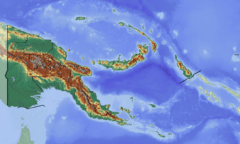Choerophryne siegfriedi facts for kids
Quick facts for kids Choerophryne siegfriedi |
|
|---|---|
| Conservation status | |
| Scientific classification | |
| Choerophryne siegfriedi is only known from Mount Elimbari in the Simbu Province, Papua New Guinea. | |
| Synonyms | |
|
Albericus siegfriedi Menzies, 1999 |
The Siegfried's Choerophryne (Choerophryne siegfriedi) is a tiny type of frog. It belongs to the Microhylidae family, which includes many small frogs. This special frog is found only in Papua New Guinea. It lives on Mount Elimbari in the Simbu Province.
What's in a Name?
This frog was first called Albericus siegfriedi. The name Albericus comes from Alberich. He is a dwarf character in old Scandinavian stories. He also appears in Richard Wagner's famous opera series, Der Ring des Nibelungen.
The scientist who named this frog, Menzies, often named new species after characters from these myths. So, siegfriedi comes from Siegfried. He is another important character in the same stories.
How to Spot This Frog
These frogs are quite small. They measure about 18 to 21 millimeters long. That's less than an inch! Their bellies can be reddish, yellowish, or whitish. Sometimes they have spots, and sometimes they are just a solid dark color.
The Siegfried's Choerophryne looks a lot like another frog called Choerophryne darlingtoni. But you can tell them apart by their calls. The Siegfried's Choerophryne makes a sound like a "squeak." It repeats this squeak in a series, but not always at regular times.
Where This Frog Lives and How We Protect It
The Siegfried's Choerophryne lives in mountain rainforests. These forests are very high up, about 2,400 to 2,500 meters (around 8,000 feet) above sea level. This frog has a special way of developing. Unlike many frogs, it doesn't have a tadpole stage that lives in water. Instead, the young frogs develop directly inside the egg.
This frog used to be very common where it lives. However, its home is now at risk. People clearing land for other uses is a big problem. This breaks up the forest into smaller pieces, which is called habitat fragmentation. Wildfires are also a threat to their homes. Sadly, this frog is not known to live in any protected areas right now.



